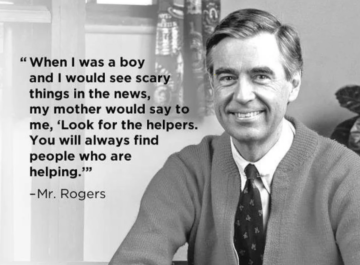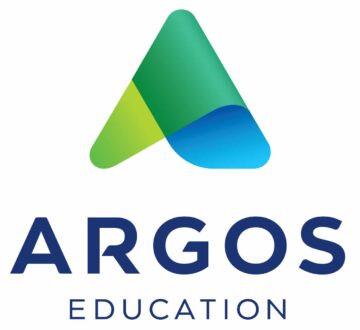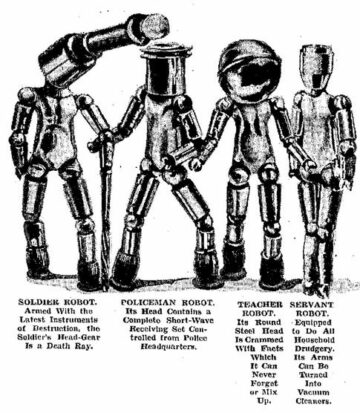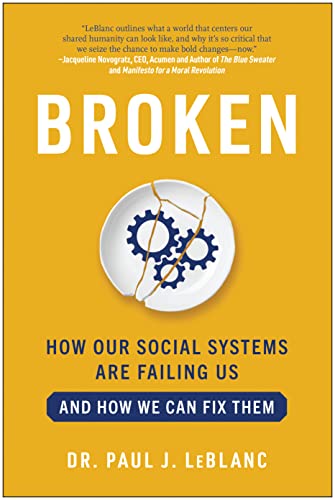
As I outlined recently in my “e-Literate’s Changing Themes for Changing Times” post, I am shifting my coverage somewhat. I’ll be developing and calling out tags I use for these themes so that you can go to an archive page on each one. This one will be listed under the “changing-enrollment” and “future-of-academic-work” tags.
Several articles caught my eye this week. Connecting the dots, I’m seeing two patterns emerging. First, post-traditional students being recruited aggressively by a surprisingly broad swath of colleges and universities. One could argue this trend started with the MOOCs and with OPMs like 2U moving upmarket, if you consider employed white-collar college graduates as post-traditional. This target group is now expanding to students who either didn’t complete their degrees or didn’t go to college at all. Meanwhile, early signs suggest that “traditional” college students are looking more like post-traditional students in that more of them are not willing or able to give up their work and home lives to spend four years immersed in a residential college experience.
If these trends hold, then the universities that have been hailed for pioneering student success initiatives under the banner of equitable education will become models for a large portion of the market that hasn’t been as driven by equity but now needs to reach an keep students who maintain lives outside of college because they need those enrollments to survive.
Enrollment shifts
We’re still in the early days of “post-pandemic” higher education.1 Enrollments have been down. Early reports suggest they are still dropping but at a slower rate. How much of that is due to the pandemic and financial hardships it caused? How much of it is because of the red hot economy? Or a combination of those two? For students who skipped college, how many of them will come back? To what degree is the demographic cliff starting to bite? How will a possible recession and escalating international tensions impact international student inflows? The combination of these questions guarantees that we will not get a simple or uniform answer as to what will happen next. Add in the fact that some of these factors are changing faster than the data are coming in, and we have a confusing picture.
So I’ll start my analysis with “As the Pandemic Wanes, All Eyes Are on Enrollment” by Liam Knox and Sara Weissman at Inside Higher Ed. As expected, the data are confusing and preliminary, while the analysis necessarily includes a significant amount of guesswork. Institutions are announcing enrollment upswings before official numbers are out. Enrollments of black, first-generation, and low-income students are down overall, according to author Nathan Grawe . On the other hand, institutions that are primarily black- and Hispanic-serving saw a 9% increase in FAFSA applications. Terry Hartle, senior vice president of government relations and public affairs at the American Council on Education tells us that selective schools have done well, as have schools in states with growing populations.
Pennsylvania State System of Higher Education Dan Greenstein is quoted as saying,
There’s no way to fill that gap on the back of what I’m going to call traditional students, high school age[.]… And there’s no way to fill that gap on the back of students who can afford the relatively high price of higher education. You’ve got to figure out a way to open the aperture.
Dan Greenstein, “As the Pandemic Wanes, All Eyes Are on Enrollment“
Right. This is where we are headed. For a variety of short- and long-term reasons, recruitment of traditional students is no longer a complete path to financial stability. The quote above is from the chancellor of a state system that has been in academic crisis since before the pandemic. But very few institutions feel safe right now.
Here’s another revealing quote:
At William Paterson University in New Jersey, matriculation rates fell by over 10 percent this fall; meanwhile, enrollment in its online programs, collectively known as WP Online, grew by 57 percent.
“Our online growth is good news and a testament to the quality and appeal of our offerings,” the university’s president, Richard Helldobler, wrote in a letter to faculty. “However, the full-time, main campus population is the biggest source of revenue, so reversing these declines is imperative.”
This university president is giving us a view into how leadership is thinking in some institutions. Online enrollment has grown by 57 percent for his university but the full-time, main campus population is the biggest source of revenue. Maybe this is a recruitment problem in the short term. But do we know if that shift to online is temporary? Maybe the real long-term solution is to switch up the revenue mix by leaning into the growth in online.
Meanwhile, in a section titled “Private Colleges Branch Out to Stand Out,” the article tells us “A Pew Research Center analysis released this month noted that Hispanic enrollment more than doubled in the last two decades, growing from 1.5 million in 2000 to 3.8 million in 2019.” Many of them, interestingly, are going to public four-year institutions. But we also get this anecdote:
Chris Domes, president of Neumann University, a small private Catholic institution in Pennsylvania, also believes his university was spared the declines faced by some other small private institutions thanks to its focus on underrepresented students.
Enrollment at Neumann fell from 2,506 students to 2,212 last year, but it held steady this fall, and first-year enrollment rose 9.5 percent compared to last year. The majority of the freshman class, 63 percent, are first-generation college students. About 40 percent of the student body are students of color, and more than 40 percent are eligible for the Pell Grant.
“We serve a big percentage of underserved populations,” Domes said. “The demographic shifts are primarily in white and wealthier communities … We feel the community we’re serving is another piece of headwind against the demographic shift, because those are not where the drops are.”
Here’s another university president telling us about his sustainability strategy. He is describing underserved populations not as an equity mission but as a sustainability opportunity. This doesn’t mean that the university only sees underserved students as revenue sources. Rather, it suggests that equity and sustainability goals are increasingly aligning for a broader range of institutions.
Anyway, while the Inside Higher Ed article authors do a good job of trying to present chaos in an orderly, sense-making way, chaos is chaos. We don’t know where enrollments are actually headed. We know a little more about how the universities are reacting to the change. For the short-term, many of them are trying to improve their recruitment of whoever they traditionally have been able to recruit. But some are beginning to recognize that the pool they have been fishing in is too small and getting smaller. To thrive in the future, they will need to reach and serve different students.
Online explodes
Meanwhile, Campus Technology‘s Rhea Kelly reports that “Student preference for Online Learning [is] Up 220% Since Pre-Pandemic“. The headline comes from a 2022 EDUCAUSE servey. It’s a staggering number.
Here’s how the preferences break out in 2022:
Seventy-seven percent of students surveyed want to take at least some online courses. In fact, 26% of students who are opting for “mostly face-to-face,” leaning into the traditional campus experience, still want to have some online courses. And 51% percent of students surveyed want half or more of their courses to be virtual. Preferences are shifting:
Think about this for a moment. How have your own work preferences have shifted regarding the mix of in-person and virtual work meetings? How have your colleagues’ preferences shifted? What are the pros and cons? When you dig down a layer below your global preferences, which sorts of activities are you more likely to want to have virtually and which would you prefer to have in person? What’s the calculus for you? For most of us, these preferences have some texture to them related to how you get your best work done, how you socialize, and how you need to balance work with the rest of your life. Why should we expect students to be different?
At the moment, we don’t have any way to correlate the winners and losers in the Inside Higher Ed article with changing online learning preferences in the EDUCAUSE report. All we have is the one anecdote from William Paterson university. Well, not quite all. The student quotes from the “modality preferences” section of the report are quite consistent with what we would expect to hear from post-traditional students, e.g.,
Having to commute would be more stressful. It would probably negatively impact my learning because I have a job that I have to prioritize over school with regard to my schedule.”
[And also]
I won’t be able to finish my degree unless I can do it online. My dad is in remission from cancer and doesn’t have any protection from COVID.
“2022 Students and Technology Report: Rebalancing the Student Experience,” EDUCAUSE
These are students with lives outside of school. Now, we don’t know too much about the sample. And yet, 71% of them are in the 18-24 age bracket. About a third of them were in community colleges, but 25% were in PhD-offering public universities. It certainly feels like the needs and preferences of “traditional” and “post-traditional” students may be merging.
Spending money to reach students
The third story I want to bring up, by Doug Lederman of Inside Higher Ed, is “When to Outsource Online Learning, and When Not To.” It provides a summary and analysis of a report from UPCEA on how to decide whether to hire an OPM or build in-house capability for online learning programs.
After pointing to other OPM reports, the article contrasts the UPCEA report in the following way:
The report doesn’t explore the question of whether institutions should expand their online offerings, or the all-important question of how to go about going online in a way that furthers their educational mission. It picks up at the point where a college or university leadership might decide how to do so—utilizing its own money, people and capacity, or with outside help.
UPCEA’s report is a “how to” guide. And the most desired features highlighted in the analysis are funding the development of a program and marketing it, the latter of which got particular attention. “[B]uilding the enrollments, typically through (sometimes) sophisticated digital marketing efforts—tends to be the skill set that most institutions believe they lack in house….”
This quote from Tyton Partners’ Trace Urdan made me sit up in my chair:
“Attracting working adult students to graduate programs and degree-completion programs is extremely difficult at the current moment for everyone given competition from a still-hot labor market,” Urdan said. “No one is happy with leads or conversions, and no one anticipated how challenging the current moment would be. This is a problem for everyone, not just OPMs.” [Emphasis added.]
Trace rightly connects degree completion programs—often associated with institutions like WGU and SNHU—with graduate programs, including the ones for elite universities served by the likes of 2U. (2U, by the way, just announced its first MicroBachelors programs.) Whatever a student’s age bracket and educational attainment may be, if she has a life and priorities outside school, she is going to be harder to reach and harder to keep. She has less attention to give and few resources in general.
The post-traditional student is becoming the new traditional student.
Some implications
The 20th Century was a kind of golden age of the traditional liberal arts university in the sense that the pool of 18-year-olds who aspired to go to college expanded dramatically while the cost remained affordable. While nstitutions competed with each other, most did not have to work to convince students to go to college straight from high school, attend full-time, and make college the main focus of their lives. I believe those days are over. They are not coming back. On the other hand, lifelong learning used to be a lifestyle choice for most people. Now it’s a necessity for many. Higher education must embrace these realities to survive, thrive, and above all, serve its purpose in the 21st Century.
If I’m right about this, then the majority of US colleges and universities need to rethink and retool. Tim Renick’s work at Georgia State University to reduce summer melt and reduce administrative barriers for students to success will no longer be seen as primarily an equity effort for the underserved. It will become a template for all kinds of institutions. The lessons learned by large online universities like SNHU, WGU, UMGC, and ASU Online about how to retain online students and deliver quality online education will be lessons that residential campuses will have to embrace. Every college education will be digitally enabled. Even the most traditional residential campus will need to embrace online, blended, and hybrid as parts of the mix that its students demand. After all, even students who can afford to focus on nothing but college for four years will expect to have as much freedom to work remotely as knowledge workers do these days. Everything from physical plants to term lengths to degree structures will have to be rethought for mainstream institutions.
This, in turn, will change the daily work lives and even the professional identities of many people working on these campuses. The nature of the professorate will change. Universities will need to become more centrally managed and coordinated. And this may happen shockingly quickly as universities face existential pressures for survival. This is what punctuated equilibrium looks like. Positive feedback loops run amok. The unthinkable becomes possible and then inevitable.
The last ice age endured for 11,000 years. But it did end.
- SEO Powered Content & PR Distribution. Get Amplified Today.
- Platoblockchain. Web3 Metaverse Intelligence. Knowledge Amplified. Access Here.
- Source: https://eliterate.us/post-traditional-students-are-the-new-premium-students/
- 000
- 1
- 11
- 2019
- 2022
- 7
- 9
- a
- Able
- About
- above
- academic
- According
- activities
- actually
- added
- administrative
- Adult
- affordable
- After
- against
- All
- American
- amount
- analysis
- and
- Announcing
- Another
- answer
- Anticipated
- appeal
- applications
- Archive
- argue
- article
- articles
- Arts
- associated
- attend
- attention
- author
- authors
- back
- Balance
- banner
- barriers
- because
- become
- becomes
- becoming
- before
- Beginning
- being
- believe
- believes
- below
- BEST
- Biggest
- Black
- body
- Branch
- Break
- break out
- bring
- broad
- build
- call
- calling
- Campus
- Cancer
- Capacity
- caught
- caused
- Center
- Century
- certainly
- Chair
- challenging
- change
- changing
- Chaos
- choice
- class
- collectively
- College
- Colleges
- Colleges and Universities
- color
- combination
- come
- coming
- community
- Commute
- compared
- competed
- competition
- complete
- completion
- confusing
- Connecting
- connects
- Cons
- Consider
- consistent
- conversions
- convince
- coordinated
- Cost
- could
- Council
- courses
- coverage
- Covid
- crisis
- Current
- Dad
- daily
- data
- Days
- decades
- Declines
- Degree
- deliver
- Demand
- demographic
- developing
- Development
- DID
- different
- difficult
- DIG
- digital
- digital marketing
- digitally
- Doesn’t
- Dont
- doubled
- down
- dramatically
- driven
- Dropping
- Drops
- each
- Early
- economy
- ed
- Education
- educational
- edx
- effort
- either
- eligible
- elite
- embrace
- emerging
- emphasis
- Equilibrium
- equity
- Even
- everyone
- everything
- existential
- Expand
- expanded
- expanding
- expect
- expected
- experience
- explore
- extremely
- eye
- Eyes
- Face
- faced
- factors
- Fall
- faster
- Features
- feedback
- few
- Figure
- fill
- financial
- financial stability
- First
- Fishing
- Focus
- following
- Forbes
- Freedom
- from
- funding
- future
- gap
- General
- Georgia
- get
- getting
- Give
- given
- Giving
- Global
- Go
- Goals
- going
- Golden
- good
- good job
- Government
- graduate
- grant
- Group
- Growing
- grown
- Growth
- guarantees
- guide
- Half
- happen
- happy
- hardships
- headed
- headline
- Held
- help
- High
- higher
- Higher education
- Highlighted
- hire
- hold
- Home
- HOT
- How
- How To
- HTTPS
- Hybrid
- I’LL
- ICE
- identities
- immersed
- Impact
- imperative
- improve
- in
- includes
- Including
- Increase
- increasingly
- inevitable
- inflows
- initiatives
- Institution
- institutions
- International
- IT
- Job
- Keep
- Kind
- Know
- knowledge
- known
- knox
- labor
- labor market
- Lack
- large
- Last
- Last Year
- layer
- Leadership
- Leads
- learned
- learning
- Lessons
- Lessons Learned
- letter
- Level
- Licensed
- Life
- lifestyle
- likely
- Listed
- little
- Lives
- long-term
- longer
- looking
- LOOKS
- Losers
- made
- Main
- Mainstream
- maintain
- Majority
- make
- managed
- many
- many people
- Market
- Marketing
- Meanwhile
- meetings
- merging
- might
- million
- Mission
- models
- moment
- money
- Month
- more
- most
- moving
- Nature
- necessarily
- Need
- needs
- negatively
- New
- news
- next
- noted
- number
- numbers
- Offerings
- official
- ONE
- online
- online education
- Online Learning
- open
- Opportunity
- Other
- outlined
- outside
- outsource
- overall
- own
- pandemic
- particular
- parts
- path
- patterns
- Pennsylvania
- People
- percent
- percentage
- person
- PEWRESEARCH
- physical
- Picks
- picture
- piece
- Pioneering
- plants
- plato
- Plato Data Intelligence
- PlatoData
- Point
- pool
- population
- populations
- positive
- possible
- Post
- prefer
- preferences
- Premium
- present
- president
- price
- primarily
- Prioritize
- private
- probably
- Problem
- professional
- Program
- Programs
- PROS
- protection
- provides
- public
- purpose
- put
- quality
- question
- Questions
- quickly
- range
- Rate
- Rates
- reach
- Read
- real
- realities
- reasons
- rebalancing
- recently
- recession
- recognize
- recruitment
- Red
- reduce
- regarding
- related
- relations
- relatively
- released
- remained
- report
- Reports
- research
- Resources
- REST
- revenue
- Richard
- ROSE
- Run
- safe
- Said
- schedule
- School
- Schools
- SEA
- Sea level
- Section
- seeing
- sees
- selective
- sense
- serve
- serving
- set
- shift
- SHIFTING
- Shifts
- Short
- short-term
- should
- significant
- Signs
- Simple
- since
- skill
- small
- smaller
- So
- socialize
- solution
- some
- somewhat
- sophisticated
- Source
- Sources
- spend
- Stability
- stand
- start
- started
- Starting
- State
- States
- steady
- Still
- Story
- straight
- Strategy
- Student
- Students
- success
- Suggests
- SUMMARY
- summer
- surveyed
- survive
- Sustainability
- Switch
- system
- Take
- Target
- Target Group
- Technology
- tells
- template
- temporary
- testament
- The
- The Future
- their
- Thinking
- Third
- this week
- Thrive
- Through
- titled
- to
- too
- trace
- traditional
- traditionally
- Trend
- Trends
- TURN
- typically
- under
- underrepresented
- underserved
- Universities
- university
- us
- use
- variety
- Vice President
- View
- Virtual
- virtually
- week
- What
- whether
- which
- while
- white
- WHO
- whoever
- will
- willing
- winners
- Work
- workers
- working
- would
- year
- years
- Your
- zephyrnet







